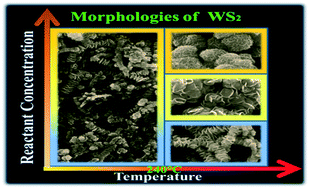Controlled preparation of high quality WS2 nanostructures by a microwave-assisted solvothermal method†
Abstract
Thin-layered WS2 nanostructures have attracted great attention owing to their superior structures and properties when compared to MoS2, including larger layer-spacing, higher energy gap and better photothermal and lubrication properties. However, it is still challenging to prepare high-quality WS2 nanosheets and assemble them into large quantities. In this work, we report a facile and efficient microwave-assisted solvothermal method for the synthesis of WS2 nanostructures in N-methyl-2-pyrrolidone (NMP) using cheap tungsten hexachloride (WCl6) and elemental sulfur (S) as starting materials. The formation of WS2 nanosheets and their controlled assembly into different morphologies (such as nanocones and nanoworms) were studied by adjusting the reactant concentration and reaction temperature. This method has also been successfully applied for preparation of other transition-metal dichalcogenides such as MoS2. The resulting WS2 and MoS2 nanomaterials were characterized by transmission electron microscopy (TEM), scanning electron microscopy (SEM), X-ray diffraction (XRD), X-ray photoelectron spectroscopy (XPS) and Raman spectroscopy. The photothermal properties of WS2 nanostructures have been investigated and it was found that the WS2 nanosheets have the best photothermal efficiency and stable photothermal capacity, exhibiting great potential for photothermal therapy and other fields.



 Please wait while we load your content...
Please wait while we load your content...